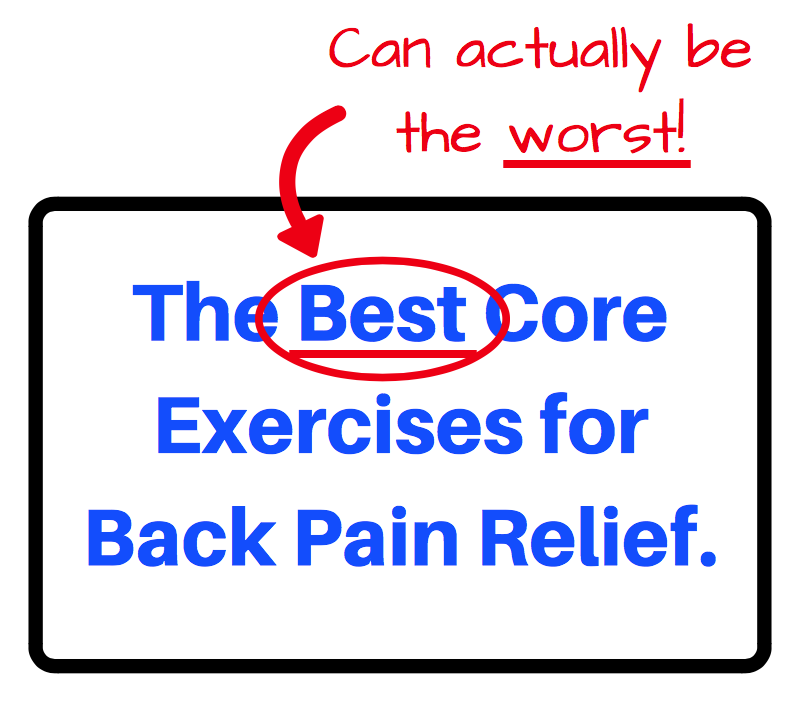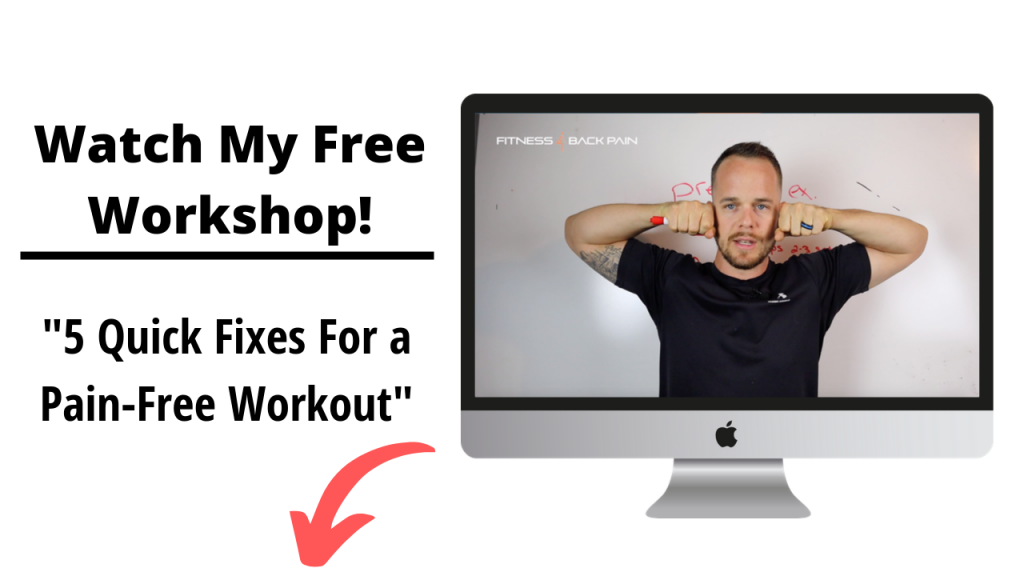
If you were to google “core exercises for back pain” right now you would get a couple articles from webmd.com and Spine-health.com’s site talking about generic exercises they prescribe to any and all who are willing to click and consume what they have to say. It drives me crazy because like any other normal human being typically the first thing that pops up in google is the first thing we go to seek answers to our questions from. It’s because of this that millions of back pain sufferers are having the wool pulled over their eyes and guided down a path with zero chance of getting the relief they want and deserve.
This freaking drives me crazy.
Today we are going to bust the medical and fitness industry-wide open and explain why you can’t always apply what the guru’s are saying.
I’ll be the first to admit it. When I started coaching people with their training and back pain relief strategy I was using a lot of the run of the mill suggested exercises. I understood the importance of core training and it’s effect on the lumbar spine. I understood that the most important focus for someone cleared for activity after a spinal fusion, discectomy, laminectomy etc. was to learn to stabilize the area, move properly and safely. I even understood the many ways of altering an exercise if the student couldn’t do it without their pain getting worse.
I was the man with the plan.
This strategy worked but there were always those students that I couldn’t seem to get across to. Its like I would tell them to do something a certain way and no matter what they did or how I coached it they just couldn’t make it happen the way I would have thought they could. I started experimenting with some of these myself when it came to my own recovery strategy and started to pick out the disconnect that I was seeing in my students. The problem that I had was that these disconnects were severely altering the students ability to progress the way they should. Not only that, there wasn’t anyone teaching what to do when the core training you were doing wasn’t working.
Over the years I continued to unpack this core training issue on myself and started to apply it to everything I did. During this process, I discovered 3 major issues that we as back pain students need to be aware of that the medical and majority of the fitness industry is not making clear.
3 reasons not to follow the first page of Google when it comes to core training for back pain relief.

Let’s go back to the google search results. The exercises you are doing on the entire first page of results are blanket, catch-all exercises. I understand that one single article can’t cover the entire population of back pain sufferers but being ranked number one on the internet is literally destroying millions of peoples chance at really learning what core training should be about.
This is why.
For the hundreds of thousands of people who are going to try those exercises and still have pain weeks, months and years later, they have no alternative options. The doctor says to do more sit-ups so you do more sit-ups. You read online that planks are the beez-kneez for back pain, so you try and hold planks for as long as possible. We put so much weight into the first page of google but what happens if what we apply to our own strategy doesn’t freakin work? What if the exercises we are reading about cause more pain or shouldn’t even be done by anyone with back pain at all!? This is where we have to dig even deeper. We have to look past what we are being taught. For the average person, this is near impossible because they are not wired to ask questions to questions. They have way more important things to think about then reverse engineering their core training program.
I am super pumped for next week! I am going to be diving into what this looks like and how you can break this cycle of bad information (i’ll be talking about this in my newsletter so don’t miss out on that info GET CONNECTED HERE

So what happens when you’re doing the plank and after 15 seconds your in pain? You may be able to find some alternatives to planks but normally this sends you down a rabbit hole of information that ends up doing more harm than good. So you go back to the alternative version of the plank to see if that helps and guess what…it doesn’t.
What happens next?
Well usually 1 of 2 things happen.
1 – You keep going back to your physio doing the same exercises he/she gives you until you either run out of cash or medical coverage. You get as far as it would take you and may have even seen some results but now you are at a place in your recovery where you need the “next steps” but your bank account says your on your own.
2 – You chalk it up as a loss and go ahead and schedule the 4 level fusion to “fix” your DDD or herniated discs you have. This puts a band-aid on the issue but 6 months to a year later your back with the same issues looking for the same guidance to what you should have been doing before you even considered to operate
The kicker is, your natural instincts are right. “This exercise is not working for me so I need to seek out another way of doing it that does.” That’s great but that’s where the information stops. Nobody is talking about anything other than the big exercises like Stir the Pots, Planks, Bird Dogs and Dead Bugs (to name a few). You may find a good clinic that is using great developmental techniques on their students but what good does that do if you can’t work with them? We live in the information world. You shouldn’t have to pay 90$ per visit, 3 visits a week for 6 months just to get 3/4 of the way through an entire recovery strategy. This is what I have set out to do with this site. Break down the stuff that is not working for you and show you an alternative to what is being blasted over the internet. You don’t need another blanket option. You need a complete system that leaves nothing out.

This practice of developmental core training is something that I have picked up over the years that has filled in the gaps that I have been struggling with for so many years. I am seeing more and more of a disconnect with some of the simple engagements we learn as babies that should still be prevalent in our later stages in life but due to desk jobs, sedentary lifestyles, poor movement mechanics etc. some of these key abilities get lost. Our bodies continue to function and do the job they were created for but they begin to break down.
There are a few different ways to approach this missing “developmental stages” of core engagement, coordination and movement. You can’t just instruct verbally some of the things you have to work through. The biggest reason for this is nothing you learn really has a common household name. Exercises like Stir the Pots, Planks, Bird Dogs and Dead Bugs have been used so much and so often that most people are familiar with what to do. But if you can’t do a plank without pain you need to break that down to learn how to engage your deep core while on all 4’s. I have no clue what that should be called other then what I just said. If you can’t engage your deep core on all 4’s then you have to know how to palpate your deep core while laying on your back and going through proper breathing cycles before you do any kind of movement.
Again, no clue what to call that but it’s extremely necessary for you to master those developmental stages of core activation and strengthening before you move onto the big stuff. It is complicated but it can be 100% taught. You won’t find it googling “best core exercises for back pain” but I’ll tell you what there is a world of core training out there that is far better then what those google searches will find you. That stuff is great but 90% of back pain sufferers should NOT be starting there.
The medical Industry and majority of fitness gurus mean well but they are really giving the back pain industry a disservice.
Next week I am going to speaking directly to my newsletter readers. If anything we have been talking about this week has struck a nerve with you or you can raise your hand and say yes! The mainstream core exercises for back pain protocols suck and I have no idea where to even begin to find the right answers make sure you get connected and join us in the conversation!
See you next week!
William


1 thought on “The Best Core Exercises Can be the Worst for you”
Comments are closed.